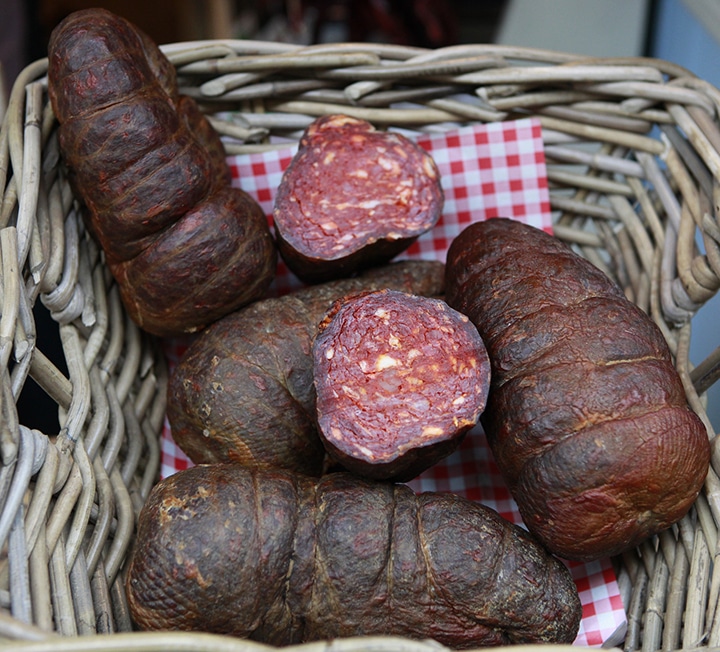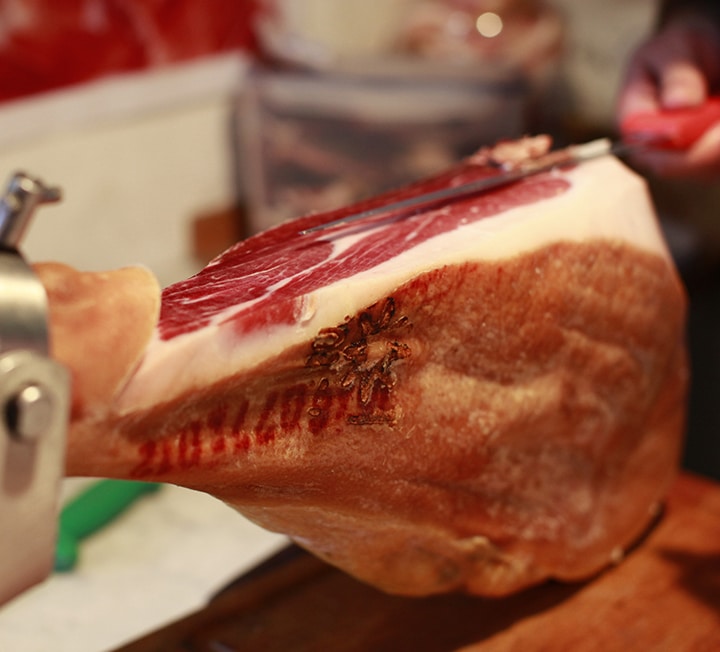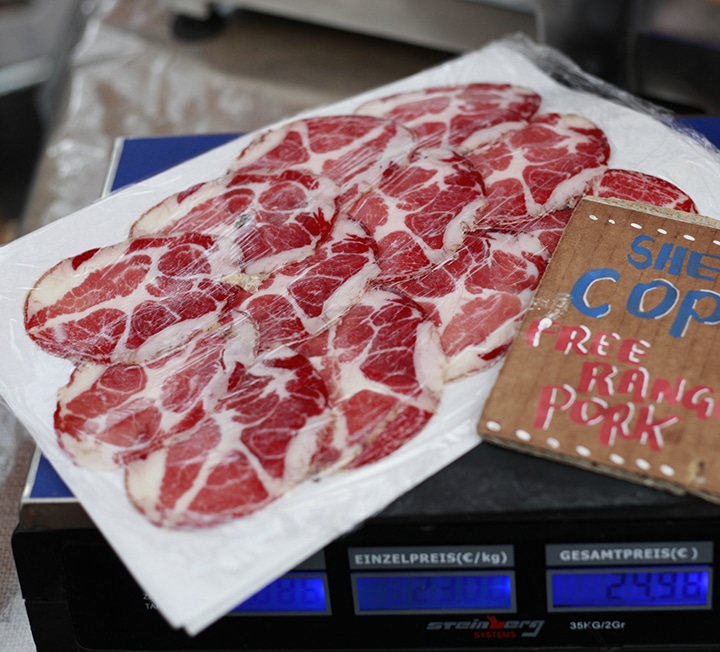Cut & dried: French charcuterie
Ed Smith explores the nature of French charcuterie and explains what distinguishes this country’s cured meats from other classic European traditions


“CRUCIALLY, FRENCH CHARCUTERIE IS ABOUT PRESERVING MEAT AS A COOKED ITEM, AS WELL AS AIR-DRYING AND SMOKING”
Words: Ed Smith / Image: John Holdship
Having covered Italian salumi in some detail (see Italian salumi parts one and two), you might well ask what more there is to write on the subject, even in the context of other European countries. Whether it’s called salumi, charcuterie (French, Spanish and English), wurstwaren (German) or something else, isn’t cured meat all the same – just pork, beef or venison, salt, maybe some flavourings, and time? Answer: non.
We could, of course, go into great detail about different breeds of pigs – for example, the qualities of Iberian black pig that becomes jamon Iberico de bellota versus that of the Basque pig that’s used to make jesus du pays Basque. We might also consider the impact of climactic conditions on resulting meat products, for example areas with a warm sea breeze (such as that which is harnessed by the makers of prosciutto di San Daniele) versus cold and wet environments in Alpine regions, which tend to foster smoked rather than simply air-dried meats.
But perhaps it’s useful to take a more simplistic, bird’s-eye view. Literally: imagine walking round a French town or market, compiling a charcuterie platter, then using your phone to take a ‘flat lay’ image for Instagram. How would it look? What’s discernibly ‘French’ about it? How does it differ from something you might put together in Tuscany, southern Spain or Germany? To my mind, the thing that makes a French platter stand out is that it’s not simply a selection of air-dried meats (though saucisson and sliced muscle meats are important): in France, there’s more variety to the genre. On a French board, there’ll be some ‘soft’ charcuterie too, a pâté or terrine, maybe a big clump of rillettes.
Crucially, French charcuterie is about preserving meat as a cooked item, as well as by way of air-drying and smoking. In fact, the word charcuterie derives from ‘chair cuit’, meaning ‘cooked meat’. Long before they were licensed to sell raw sausages and smoked and air-dried meats, charcutiers were first and foremost purveyors of cooked meat products, and this tradition still impacts what the charcutiers and butchers in French villages and towns offer now.
It’s interesting that Jane Grigson’s seminal Charcuterie and French Pork Cookery barely touches on saucisson sec, let alone air-dried hams. Those items do of course exist, but it does emphasise the fact that, if you want to serve an authentic French meat board, you need to begin with the soft stuff.
Soft charcuterie at the Market
Grigson notes that the words ‘pâté’ and ‘terrine’ are used relatively interchangeably, and she tends towards suggesting that pâté is the general term to cover all types of forced or minced meats that are gently cooked, with plenty of fat and gelatinous stock, so that they last in a mould for a good few days. It’s sometimes the case that terrines are made in straight-sided, rectangular moulds, and are often relatively coarse; pâtés are smoother, sometimes mousse-like in form. But then, technically, the filling of a hand-raised pie (whether a round pork pie or something more decorative) is a pâté.
In short, don’t get too caught up in semantics. Do, instead, sample and buy some of the many pâtés on offer at The French Comte. These are coarse country pâtés, some involving apricots, based mostly on venison or boar rather than pork. Pâté seasonings and peculiarities are almost infinite and generally follow regional preferences and ingredients – one of The French Comte’s pâtés is seasoned with pine needles, reflecting the Alpine fauna of the Jura region.
A rillette is more easily defined as cooked, pulled and potted fatty meat. It tends to be pork belly sat in its own fat (or the fat of a duck or goose), though it can also apply to potted goose, duck or rabbit (also plus goose or pork fat). Le Marché du Quartier is an excellent place to head for rillettes, as is The French Comte.
Smoked and air-dried charcuterie at the Market
It’s not clear whether the French created the smallish, air-dried and sometimes smoked saucisson, but they’re both prolific and very good at making them. Any French market will have buckets of these small, often quite hard cured and dried sausages. They’re typically flavoured with black peppercorns or rosemary, or perhaps they’re quite plain. At Borough Market, Une Normande a Londres has a wondrous selection of them. Use a knife to cut discs somewhere between the thickness of a 50p and £1 coin.
Air-dried meats from the Jura
Perhaps saucissons are so prevalent in France because like the UK, before modern curing technology existed, the climactic conditions across much of the country were not particularly well suited to curing and drying large muscle meats. A small sausage could be left to dry out without going mouldy. Large hams, not so much.
That said, there are still areas in France with a tradition of cured and air-dried meats – in particular, plenty of stellar hams such as bone-in Bayonne ham from the town of the same name in the Basque region (similar to a prosciutto); jambon de Savoie (cured with the bone-out – like a speck, although not salted); jambon de l’Ardèche and jambon de Lacaune from south-west France. Each use heritage breed pigs from specific regions and have minimum periods of maturation (usually between nine and 12 months). Those four hams are from relatively mountainous regions – again indicating that geography and climactic conditions are important in establishing curing traditions.
The Jura region is another environment that appears to be suited to curing, as The French Comte’s meat counter suggests. Here you can sample and buy a number of different meats, many of which are smoked, as is the region’s style. Consider, in particular, walking away with wafer thin slices of their whole hams, the smoked noix de jambon (the central muscle of a ham); some beef fillet marinated in plum brandy before being cured and dried (known as ‘tavaillon’); or dry-cured duck magret (breast), which is outstanding sliced thinly and mixed among bitter frisee lettuce leaves.
The ultimate French charcuterie board
It’s tempting to buy everything. I would suggest, however, that when it comes to putting together a charcuterie board, less is more. Select appropriate quantities (about 35-50g per person) of three different meats: one soft, one saucisson, one muscle meat. You can always come back on another occasion and put different meats into the same formation. But do always include a pile of cornichons from Borough Olives and / or turn the charcuterie board into a meal with the addition of a baguette or pain rustique from Olivier’s Bakery.
See Ed’s recipe for carottes râpées & celeriac remoulade: perfect accompaniments for French charcuterie.


